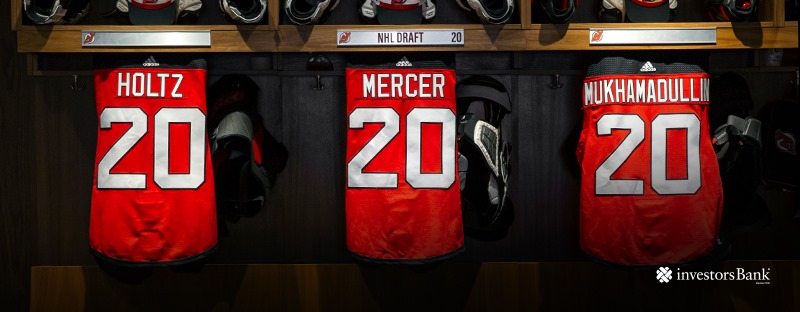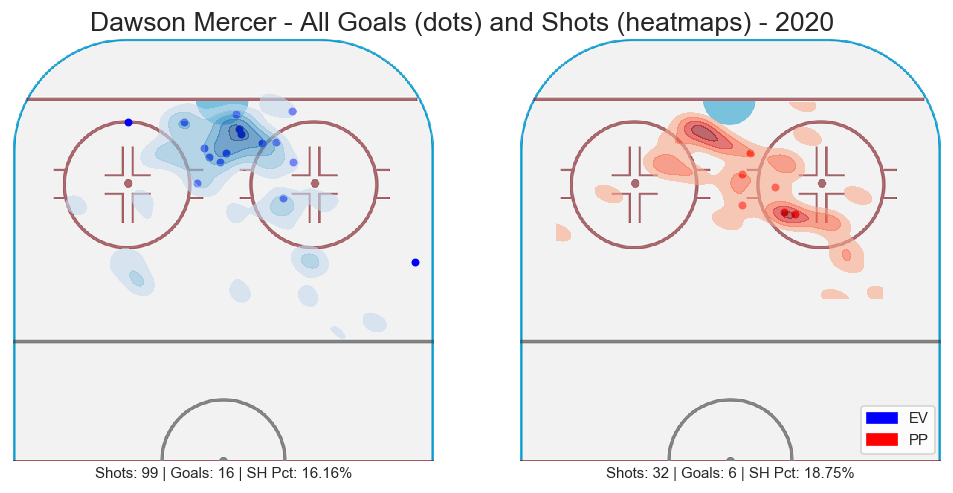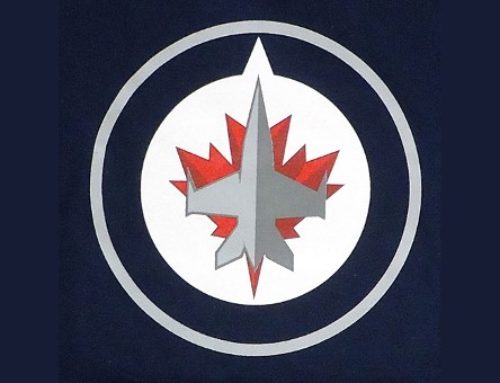November 31-in-31: New Jersey Devils
Hadi Kalakeche
2020-11-18

Photo courtesy of the New Jersey Devils
The 31-in-31 Series is an annual event here at DobberProspects! Every day in November we will be bringing you a complete breakdown of a team’s Draft, and insights into their off-season movements thus far. Following this up in December, we will dive into every team’s prospect depth charts with fantasy insights and implications for the upcoming seasons. Check back often, because we plan on filling your hockey withdrawal needs all off-season long!
As the New Jersey Devils approached the 2020 NHL Entry Draft, with three first-rounders in their left pocket and a gaping hole in their right where goal-scoring should be, the focus was obvious: get wingers for Jack Hughes and Nico Hischier.
Wingers who can rip the puck, and keep up with their pace – and if you’re lucky, a top-pair defenseman. Given the depth of the Draft class, we were blessed with this year, the odds of the Devils picking up future essential team pieces in the first round were high.
Draft day
The Devils had accumulated those first-round picks through trading essential pieces of their organization during the 2019-2020 season in Hall and Coleman, stripping their team of what little goal-scoring it had left. There was talk of adding key roster pieces by trading one of those picks, but the Devils hung on to their 7th, 18th, and 20th overall picks in order to select right-wingers Alexander Holtz and Dawson Mercer, and defenseman Shakir Mukhamadullin, respectively. Two scoring wingers who can keep the pace: check.
In Mukhamadullin, the team gets a big, mobile defenseman who activates from the defensive zone efficiently to drive offense – we will circle back to his game further below.
The Russian defenseman was expected to hear his name in the forties according to most rankings, which made this pick confusing. Teams choosing “their guy” and sticking to him was a recurring theme in this first round. Prospects Marco Rossi, Cole Perfetti and Anton Lundell (and later on, Hendrix Lapierre, Connor Zary, Jacob Perreault, and Mavrik Bourque) fell into teams’ laps because teams above them picked the player they wanted or needed, but not the best player available. Yegor Chinakhov better be as good as Columbus seems to think he will be.
Day two
The second day of the 2020 NHL Draft seemed to last an eternity; grey hairs grew on the excited prospects’ heads, as they awaited their selections from the comfort of their homes. New Jersey sat out the second round, having traded their pick along with next year’s second-rounder for Nikita Gusev.
When the third round came at the turn of the century, the Devils announced their fourth pick of the Draft, with the 84th overall selection: overage goaltender Nico Daws, from the OHL’s Guelph Storm. They added a couple of interesting players with their later picks in Jaromir Pytlik, Ethan Edwards, Artem Shlaine, and Benjamin Baumgartner, clearly content with choosing who was available, instead of moving up or down for specific names.
Then the Devils traded their final pick in this Draft, 192nd overall, for Arizona’s 2021 7th round selection. This pick allows the Devils to spread out their contracts over multiple years and avoid losing prospects from lack of roster space.
Post-Draft
By adding Alexander Holtz and Dawson Mercer to their prospect pool, the Devils ensure a decent amount of upside on the right wing; soon they will have two goal-scoring options for the elite playmakers that center their top lines, Holtz especially being precisely the type that thrives with a Jack Hughes or a Nico Hischier. In the meantime, GM Tom Fitzgerald faces what seems to be an impossible task for him; the task of putting a competitive team on the ice using $24 million in cap space. Given the amount of cap room New Jersey had to work with, Devils fans were understandably unimpressed by the lack of trades at the Draft table.
The day after the Draft, finally giving in to their fans’ cries for a trade, the Devils benefited from a crashing market to acquire Ryan Murray from the Columbus Blue Jackets for a fifth-round selection in 2021.
— New Jersey Devils (@NJDevils) October 9, 2020
This trade exemplifies the leverage of cap room, especially since the beginning of the pandemic: a team like Columbus, overloaded with defenders, with little cap room in a weak hockey market, giving up a decent player for next to nothing in order to make room for their stars and to alleviate the financial burden of COVID-19 related losses.
This trade is a win for New Jersey as a competitive hockey product, solidifying their back-end as Murray will likely remain in the Devils’ top-four for the 2020-2021 season. However, from a prospect development perspective, it might hinder Ty Smith’s opportunities at the NHL level this upcoming February.
Their next move, the day after the Murray trade, was similar in its assistance of a higher-spending team to remain competitive while obtaining a key piece: the Devils sent the promising Joey Anderson to the Toronto Maple Leafs for winger Andreas Johnsson. A former seventh-round pick, Johnsson adds awareness, speed, and secondary scoring to New Jersey’s top-nine on a $3.4 million AAV contract for the next three seasons, and there is no risk in seeing what could happen to him next to Hischier or Hughes. A smart move, trading a “maybe” for a “yes”.
He will also allow prospects such as Boqvist, Zetterlund, and Kuokkanen some room to grow their game and will assist in their transition as they try to develop into regular NHL players. Given New Jersey’s lack of true goal-scoring options on the wings other than Palmieri, trading for an established winger was inevitable.
The Devils then signed defender Dmitry Kulikov to a one-year, $1,15 million contract, in order to add depth to their defense core. This is another move that will add to Ty Smith’s hill of obstacles to the NHL as another left-handed blueliner joins the Devils’ depth chart, but Kulikov is a roster addition that will allow New Jersey to try and put a competitive team on the ice for next season.
Draft Recap
Round One, 7th overall – Alexander Holtz, RW
With a high pick at 7th overall, the Devils had a buffet of proper top-end talent to choose from, with Rossi, Perfetti, Holtz, Askarov, Lundell, and Jarvis all still available. The choice of 6-foot goal-scoring winger Alexander Holtz from Djurgårdens in the Swedish Hockey League was an easy one: he has the best shot in the Draft, and easily becomes their best prospect on the wing.
Holtz first raised eyebrows in the scouting sphere by putting up 30 goals in 38 games in Sweden’s U20 program, at 16 years of age. Now two years older, he shows immense versatility in his scoring chances by utilizing different shots, shooting off either leg and being able to produce both off the rush and during offensive-zone cycles. He is clinical, boasting a 15% shot percentage with 16 points (9 goals) in 35 games in the SHL in 2019-2020, a men’s league in which goals are hard to come by. Prior to his call up to Djurgårdens’ men’s team, he had collected seven goals and two assists in three (!) games against similar-age competition with their U20 SuperElit club.
He can wire the puck from anywhere on the ice, although he tests that ability a bit too much by rushing a shot from the blue line instead of looking for better options. His shot motion relies on strength over technique within his forward thrust, and that strength will only grow with proper training and nutrition from some of the best trainers in the world; that is why Holtz is an almost-guaranteed perennial 30+ goal-scorer.
Alexander Holtz is going to absolutely terrorize NHL netminders
(These are just his even-strength markers) pic.twitter.com/SVnD6lH8vF
— /Cam Robinson/ (@Hockey_Robinson) May 26, 2020
His skating is decent, and will not require much work to match the pace of the NHL’s top lines. His playmaking is intricate enough to make him a dual-threat offensive winger, and adding weight onto his frame in the next couple of years will surely contribute to his overall game as well, as he learns to separate physically from his man in the offensive zone and create more space for himself.
Questions arise when watching Holtz defend – he has a tendency to “disconnect” in his own zone, losing track of passing or skating lanes he should be blocking, or simply drifting away from his man during opposing cycles. Statistically, his team produced much better defensive numbers with him off the ice last season. However, you don’t draft Holtz for his defense – you draft him to take the puck and put it behind the goaltender. And he does that extremely well.
Holtz is a right-handed shooter, and as the prime winger in the Devils’ Draft cupboard, a long career of receiving pucks right in his wheelhouse is to be expected, as he develops next to elite playmakers in Hughes and Hischier. Fantasy-wise, he is a top-end pick in leagues with emphasis on goal-scoring, but a mid-first-round pick in multi-category leagues as he does not rack up hits, nor penalty minutes.
Holtz is currently furthering his development with Djurgårdens at the Swedish top-level, where he has accumulated four goals and two assists in nine games.
Round One, 18th overall – Dawson Mercer, RW/C
Dawson Mercer is one of the closest players to the NHL among all 2020 Draft eligibles – his game is extremely well-rounded, and he processes the game with quickness and efficiency. Mercer’s lack of elite-level skating or playmaking abilities was likely a factor in him slipping to 18th overall, as he projects to be a twenty-goal middle-six winger that coaches will love.
The #NJDevils grab Dawson Mercer with their second 1st rounder!
This is a solid pick! Mercer is a good shooter who has some good playmaking ability! @DobberProspects profile: https://t.co/jnOHwGZ2Xs pic.twitter.com/io1P1ncozK
— Tony Ferrari (@theTonyFerrari) October 7, 2020
Mercer will likely spend the next season in the QMJHL with Chicoutimi, but the defensive side of his game is already polished to the point that he wouldn’t need to assume a sheltered role once he reaches the NHL. He reads plays, intercepts passes, closes down on defenders at the blue line, and does it all with great timing. His ability to play efficiently on both the powerplay and penalty kill will definitely accelerate his transition onto NHL ice.
Mercer’s shooting abilities are mainly driven by his brain rather than his hands – he gets to the low slot for most of his shots, and his goals are much easier to obtain from there. Positionally, the young Newfoundlander seems to flow effortlessly in and out of danger areas in the offensive zone and understands the defensive side of the ice to an extent rivaled only by Anton Lundell among first-round forwards. He possesses above-average shot power and excellent accuracy, with 16.16% of his shots beating the goaltender at even-strength. An impressive metric, even at the QMJHL level.

Heatmaps courtesy of Pick224.com
Mercer is currently employed as a center in Junior and has six points (four goals) through four games in 2020-2021, but he projects as a winger long-term due to the aforementioned lack of top-end speed or playmaking.
His hands, shot and intelligence should carry him onto a second line as a fifty to sixty point player, or in a complimentary scoring role on a third line with regular twenty goal seasons – similar numbers to Kyle Palmieri would be a realistic projection. As a second-line right-winger playing behind Holtz with either Hughes or Hischier down the line, he could be a player that explodes offensively next to elite talent.
Round One, 20th overall – Shakir Mukhamadullin, LD
With the 20th overall pick, the Devils raised quite a few eyebrows by picking Mukhamadullin, who was thought to be lucky to hear his name in the first half of the second round. 2020’s defense crop was weak, however, leaving little choice for teams seeking help on the blue line.
The Devils could have traded down to obtain him but seemed to prefer picking him at 20th and not taking any chances, which indicates how highly they thought of his draft stock and the likelihood of another team taking him soon after. Given how much time teams had to scout players in-depth before the draft, this pick seems like one that was made informatively, not purely out of need.
The best part of Mukhamadullin’s game is his skating – he combines large strides with a fluid motion, accelerating using crossovers and using impressive backward mobility to snuff out opposing breakouts and zone entries in order to stop attacks before they happen. He moves swiftly in all four directions and uses his skating effectively to carry pucks up the ice and away from his own zone.
Here’s an assist by Shakir Mukhamadullin (#2020NHLDraft) but what I like about the video is the defensive play at the beginning.
Mukhamadullin steps up at mid ice and knocks the puck free from the attackers stick, all while staying in front of the attacking players. #MHL pic.twitter.com/FVH1zQyvjx
— Tony Ferrari (@theTonyFerrari) October 1, 2019
His size and reach facilitate his stick checking, which he uses efficiently and intelligently to disrupt wingers on the rush, or to block a passing or shooting lane. His positioning in the offensive zone is astute, but his defensive zone coverage does not make his teammates’ lives easier, as they will sometimes scramble to cover for his missed assignments and aggressive stick-checking.
Although he is 6-4, Mukhamadullin cannot and does not rely much on his physicality, which leaves him vulnerable when the opposition is settled in his zone and pushing towards the net. Oftentimes he will bounce off a player when initiating contact and is more likely to fall than to win the puck in a physical battle.
This is an issue that goes beyond Mukhamadullin’s lack of muscle; he initiates contact with awkward body positioning and weight transfers and does not seem to know how to maximize his chances of winning the puck. In that sense, if you were to send 5-9 Marco Rossi and 6-4 Mukhamadullin into the boards for a hundred puck battles, Rossi would likely win 90 or more of them, despite him being both shorter and lighter than the blueliner. If he rectifies this issue, however, Mukhamadullin’s ceiling will double in height.
His toolbox is raw, yet quite extensive; he uses it to alleviate opposing pressure as he skates, passes, stickhandles, or shoots his way out of trouble with ease. He has already proven his worth against men, with seven points in 21 games in the KHL with Ufa so far, as he managed the impossible task of earning quality ice-time at the Russian top-level as a teenager. Work needs to be put into Mukhamadullin’s decision-making, but the same could be said of almost every defensive prospect available at that point in the Draft.
However, the main concern with Mukhamadullin is how he will be able to bring his overall game up two or three notches to match the pace of NHL hockey. There are major holes and inconsistencies in his game that could see him follow a progression curve similar to former Devil Mirco Mueller, who was selected around the same slot in the 2013 draft by the Sharks and has similar concerns to the Russian blueliner even to this day.
Mukhamadullin should still develop into a fourth or fifth defenseman and outperform Mueller’s career given his higher offensive upside, and there is even a slight chance he ends up on a top pair long-term, but the concerns are still very much warranted. Patience is a virtue with young defensemen – with appropriate playing time and resources at higher levels of pro hockey, Mukhamadullin can work on cooking up his raw game and seasoning it with additional tools and skills in order to fill the gaps in his current play.
Round Three, 84th overall – Nico Daws, G
Nico Daws is an overage goaltender who put up the highest save percentage of any netminder in the OHL last season, with an impressive .924. He is massive, at 6-4 and 200 pounds already; he fills the net with that frame, making shooters hesitate by showing little twine behind him. Daws controls his rebounds well, but has issues with low pucks, as he leaves some exploitable breaches under his blocker and glove. He shows great athleticism when getting his limbs in the way of clear-cut chances.
Massive save for Nico Daws (@Storm_City) of the Canadian team!
Turned away Pinto's point shot and the Wahlstrom on the rebound. Daws has been really good after letting in a couple early! #WJC2020 #WorldJuniors2020 pic.twitter.com/eeqQmQk4hm
— Tony Ferrari (@theTonyFerrari) December 26, 2019
He does not like to play the puck often, choosing rather to play it safe; this inflates his numbers by causing more defensive zone grind time for his team, which generates a higher volume of low-danger shots compared to a puck-playing goaltender, who will prevent many scoring chances before they happen, but face a higher percentage of high-danger chances on opposing rushes and after failed clearing attempts. It is probably for the best, though, as Daws’ abilities on the puck do not shine through when he does intervene in play.
Daws will continue to play prime minutes for Guelph, as they gear towards a playoff push. If everything comes together for him, he could take over a backup spot within the next four years, and become a reliable 1A/1B tandem goaltender in his mid-twenties.
Round Four, 99th overall – Jaromir Pytlik, C/RW
Jaromir Pytlik dropped to the fourth round for the Devils, as he was projected to go in the early seventies. Pytlik is a massive forward at 6-3, 200 pounds already, with powerful legs and core strength that help him lean into body checks and drive to the net.
Jaromir Pytlik registered 50 points (22g, 28a) in 56 #OHL games in his draft season.
Great skater with a good size and an all around complete game, strong with the puck.
Here are all 22 goals Pytlik scored for @OHLHoundPower this season.#2020NHLDraft pic.twitter.com/47TkIsNowV
— Czech Prospects (@CZprospects) March 30, 2020
He is a forechecking specialist and is great at creating space for nimble, intelligent forwards to work their magic. He can also distribute the puck efficiently and has the ability to make a small, quick pass to a supporting player while tied up on the boards. His straight-line skating speed and acceleration are decent, allowing him to combine that with his strength to outmuscle defenders on the rush and in 1v1 situations – an ability which should translate effectively onto professional ice, as he gains more strength and muscle with proper training regimens and nutrition from pro-level staff.
Pytlik is shadowed in the Devils’ center depth chart by Hughes and Hischier, but he could eventually slot in at 3C as a checking-line, penalty-killing specialist, or as a middle-six energy winger if he fails to develop a relative consistency as a line pivot, which he hasn’t shown as of yet. He is currently oscillating between center and wing in the OHL, which does not bode well for his development in the responsibilities inherent to the center position, like faceoffs and defensive positioning.
The main setback with Pytlik, and likely a central factor in him slipping near the hundredth pick, is that his production last year in the OHL was very average for one of the oldest 2020 Draft first-time eligibles, with fifty points in 56 games. He has the tools to make a bottom-six impact, but if he cannot put up more than a point per game next season in the OHL, he will not make the lineup anytime soon. For multi-category fantasy leagues, look for Pytlik in the third round – he hits a bunch, and his above-zero plus-minus on a below-average team could project well.
Round Four, 120th overall – Ethan Edwards, LD
Edwards is an agile, fluid, and aggressive skater who loves to close gaps quickly and prevent zone entries rather than box out the slot and block shots. His small frame shapes his game, as he plays to his strengths; he pinches hard in the offensive zone because he knows he has the foot speed to get back, and he plays a conservative physical game, choosing stickwork over hits.
VIDEO: Ethan Edwards sets up Jordan Biro for the OVERTIME WINNER tonight in Whitecourt!#AJHL pic.twitter.com/5bqA26iRfQ
— Spruce Grove Saints (@sgsaints) February 22, 2020
His shot is an asset as well; he shoots with weight but struggles with accuracy at times. Edwards’ ability to move the puck into soft spots for his teammates to exploit is another trait that could project well at higher levels. He will need to work on his play once the opposing play is not suppressed and the play is in his zone since he is clearly uncomfortable in those situations. What is concerning with Edwards is that if these areas of his game are problematic at the AJHL level, they will likely be very difficult to bring up to NHL standards. If he does make the NHL, however, a productive future points-wise is something we could see from him.
Ethan Edwards will be joining Sioux City in the USHL for the 2020-2021 season and is committed to Michigan for his College debut in 2021-2022. His play at the NCAA level will be a bit more telling of his true ceiling, as he gears up against College D1 players up to 25 years old. If his play is sustainable against men, watch for Edwards’ stock to go through the roof.
Round Five, 130th overall – Artem Shlaine, C
The fifth to seventh rounds are where high upside is scarce – when choosing a prospect, the smart pick is either a player whose play is well-rounded and should see him play at least a game at the top level or a player whose ceiling is high but who will require major adjustments in his overall play to reach that ceiling. With Shlain, the Devils get a player with a slim chance of being an NHLer, but who will tear it up if he makes it.
Shlaine is a great forward skater, with good technique and acceleration in his stride. He is able to put defenders on their heels with his hands as well and can thread passes efficiently. His numbers at the high school prep level have plateaued slightly over the last two years (1.61 ppg in 2018-2019, 1.70 ppg in 2019-2020) and his underlying numbers in his six games in the USHL were decent, ending his stint third-place in Draft-year players for primary points per sixty minutes.
His main draw is his mix of speed, skill, and physicality, as he doesn’t shy away from hits or board battles. He forechecks hard for loose pucks in the offensive zone and plays a powerful, heavy game.
Shlaine has glaring concerns on the defensive side of the puck; mainly, he seems to think that the more things happen on the ice, the better. His focus is not on shot suppression or assisting the breakout; he relies on offense to drive his game, and if he manages to pan out, the offense is likely all we will get from Shlaine. He is committed to UConn for his NCAA freshman year, which starts on November 12th. A long term project, but in the fifth round, any pick with a slight chance of becoming a top-caliber offensive catalyst is an interesting swing to take.
Round Six, 161st overall – Benjamin Baumgartner, C
This pick for the Devils is extremely interesting: Baumgartner has shown the ability to play a complete game and consistently gets to dangerous areas to release shots on goal, all against men in the Swiss top-level (27 points in 37 games). He is electrifying, aggressive, and persistent, creating tons of space for his teammates to exploit. Baumgartner already plays an AHL game and could slot into Binghamton’s lineup sooner than later.
Look at this lovely goal D+2 forward Benjamin Baumgartner scored a week and a half ago. pic.twitter.com/iRETcMw8do
— Will Scouch (@Scouching) January 26, 2020
He is 5-9, and the holes in his game are mostly related to his size. Easy to push off the puck, Baumgartner might very well struggle to keep up against the physical specimens that permeate the bottom of NHL lineups. As a twice-overager, there is little chance of him outgrowing that problem, so this pick mostly relies on the size of the step between the Swiss D1 and the NHL – if the step is small, expect to see Baumgartner in a Devils jersey soon as a bottom-six forward, wreaking havoc in the offensive zone. If it is immense, the Devils might have another pick to forget, along with 95% of all sixth-rounders.
Development Camp
Once again, COVID-19 has complicated the NHL’s progression and return to play: currently, there is no official date for development camps to start for all 31 NHL teams, but since the season will likely start in February, we can expect to see development camps open sometime in January. As of right now, the camp invitees disclosed on the Devils’ Development Camp page on the NHL website are those of last year. We will soon know the details for the upcoming camp, but expect Holtz, Mercer, Daws, Pytlik and Edwards to be there. Mukhamadullin might be reluctant to pass up the very rare opportunity of playing top minutes in the KHL in order to attend camp, and Baumgartner’s season is already well underway.
Offseason Moves
The Devils’ offseason moves were expectable; they let some fringe NHL and AHL players go to free agency for roster space and traded an interesting prospect from their overflowing pool of potential in Joey Anderson, but they also added two established roster pieces via the transaction bringing in Murray and Johnsson. They then traded one Corey for another, buying out Schneider’s contract and signing Crawford as a free agent to a two-year, $3.9 million AAV deal.
Then the Devils signed Scott Wedgewood to a two-way contract, in order to put a body in front of pucks in Binghamton. Reilly Walsh was then signed to his entry-level deal; a third-round pick in 2017, the right-handed defenseman registered 27 points in 30 games for Harvard in the NCAA during his final year and will report to Binghamton for the 2020-2021 season.
Incoming: Ryan Murray, Andreas Johnsson, Corey Crawford, Dmitry Kulikov, Scott Wedgewood, Reilly Walsh
Outgoing: Joey Anderson, Corey Schneider, Mirco Mueller, Kevin Rooney, Brandon Baddock, Frederik Claesson, Zane McIntyre, Dakota Mermis, Vojtech Mozik, Julian Melchiori, Brian Strait, John Hayden
Pending RFA (as of November 2nd): Jesper Bratt, MacKenzie Blackwood
The Devils are now quite clearly in a much better position than they were prior to this off-season, with four acquired regular NHLers and two lost, among the tons of future assets they added in the 2020 Draft. With Holtz and Mercer in the system now, the Devils can rest easy knowing they have goals on the way soon, as they hope for Johnsson, Murray, Crawford, and Kulikov to help them win a couple of games in the meantime.
The Athletic’s Corey Pronman currently has the Devils second overall in the NHL for prospect pool quality following the 2020 NHL Draft, right behind the New York Rangers, and some of those prospects could jump into the lineup mid-season (Ty Smith, Jesper Boqvist and Janne Kuokkanen come to mind). If two prospects make the jump full-time and perform well this year, the Devils can safely consider the 2020-2021 season a win, regardless of their final position in the standings.
New Jersey has been rebuilding the long way, but a few intelligent moves or unexpected prospect breakouts could quickly put them in playoff contention. Jack Hughes’ sophomore season will also be a main influencer on New Jersey’s trajectory for the upcoming years; if his numbers dip further, which is the trend with sophomore players, New Jersey’s competitive hopes will likely be limited. If his production skyrockets to the level he is truly capable of, New Jersey suddenly becomes a wild-card for playoff contention.
As long as they retain their $17 million in cap space, which is an invaluable asset in the current market, the Devils will always be a favorable trade partner; GM Tom Fitzgerald will need to show patience to maximise his returns and manage his assets properly heading into the 2020-2021 season.
**
Hadi Kalakeche
Follow me on Twitter @HadiK_Scouting
Follow part two of DobberProspects’ 31-in-31 series all December! We will go through every team’s prospect depth chart one-by-one, and present fantasy insights and what to expect from the team for the upcoming season. See you next month, same date!






